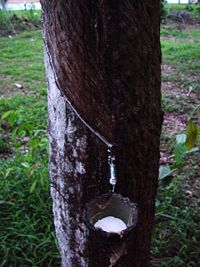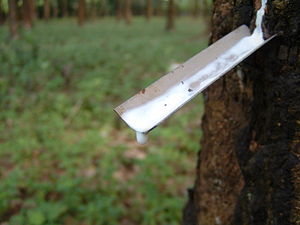Rubber
2008/9 Schools Wikipedia Selection. Related subjects: Materials science
Natural rubber is an elastic hydrocarbon polymer that naturally occurs as a milky colloidal suspension, or latex, in the sap of some plants. It can also be synthesized. The entropy model of rubber was developed in 1934 by Werner Kuhn. The scientific name for the rubber tree is Hevea brasiliensis.
Explanation
The major commercial source of natural rubber latex is the Para rubber tree, Hevea brasiliensis ( Euphorbiaceae). This is largely because it responds to wounding by producing more latex. Henry Wickham gathered thousands of seeds from Brazil in 1876 and they were germinated in Kew Gardens, England. The seedlings were sent to Colombo, Indonesia, Singapore and British Malaya. Malaya was later to become the biggest producer of rubber. Liberia and Nigeria are examples of African rubber-producing countries.
Other plants containing latex include figs ( Ficus elastica), Castilla, euphorbias, and the common dandelion. Although these have not been major sources of rubber, Germany attempted to use such sources during World War II when it was cut off from rubber supplies. These attempts were later supplanted by the development of synthetic rubber.
Synthetic rubbers are made by the polymerization of a single monomer or a mixture of monomers to produce polymers. These form part of a broad range of products extensively studied by polymer science and rubber technology. Examples are SBR, or styrene-butadiene rubber, BR or butadiene rubber, CR or chloroprene rubber and EPDM (ethylene-propylene-diene rubber)
History
In its native Central America and South America, rubber has been collected for a long time. The Mesoamerican civilizations used rubber mostly from Castilla elastica. The Ancient Mesoamericans had a ball game using rubber balls (see: Mesoamerican ballgame), and a few Pre-Columbian rubber balls have been found (always in sites that were flooded under fresh water), the earliest dating to about 1600 BC. According to Bernal Díaz del Castillo, the Spanish Conquistadores were so astounded by the vigorous bouncing of the rubber balls of the Aztecs that they wondered if the balls were enchanted by evil spirits. The Maya also made a type of temporary rubber shoe by dipping their feet into a latex mixture. Rubber was used in various other contexts, such as strips to hold stone and metal tools to wooden handles, and padding for the tool handles. While the ancient Mesoamericans did not have vulcanization, they developed organic methods of processing the rubber with similar results, mixing the raw latex with various saps and juices of other vines, particularly Ipomoea alba, a species of Morning glory. In Brazil the indigenous population understood the use of rubber to make water-resistant cloth. A story says that the first European to return to Portugal from Brazil with samples of such water-repellent rubberized cloth so shocked people that he was brought to court on the charge of witchcraft.
When samples of rubber first arrived in England, it was observed by Joseph Priestley, in 1770, that a piece of the material was extremely good for rubbing out pencil marks on paper, hence the name 'rubber'.
The para rubber tree initially grew in South America, where it was the main source of what limited amount of latex rubber was consumed during much of the 19th century. About 100 years ago, the Congo Free State in Africa was a significant source of natural rubber latex, mostly gathered by forced labor. The Congo Free State was forged and ruled as a personal colony by the Belgian King Leopold II. After repeated efforts (see Henry Wickham) rubber was successfully cultivated in Southeast Asia, where it is now widely grown.
In India commercial cultivation of natural rubber was introduced by the British Planters, although the experimental efforts to grow rubber on a commercial scale in India were initiated as early as 1873 at the Botanical Gardens, Kolkata. The first commercial Hevea plantations in India were established at Thattekadu in Kerala in 1902.
Properties
Rubber exhibits unique physical and chemical properties. Rubber's stress-strain behaviour exhibits the Mullins effect, the Payne effect and is often modeled as hyperelastic. Rubber strain crystallizes.
Chemical makeup
Aside from a few natural product impurities, natural rubber is essentially a polymer of isoprene units, a hydrocarbon diene monomer. Synthetic rubber can be made as a polymer of isoprene or various other monomers. The material properties of natural rubber make it an elastomer and a thermoplastic. However it should be noted that as the rubber is vulcanized it will turn into a thermoset. Most rubber in everyday use is vulcanized to a point where it shares properties of both i.e. if it is heated and cooled it is degraded but not destroyed.
Elasticity
In most elastic materials, such as metals used in springs, the elastic behaviour is caused by bond distortions. When force is applied, bond lengths deviate from the (minimum energy) equilibrium and strain energy is stored electrostatically. Rubber is often assumed to behave in the same way, but it turns out this is a poor description. Rubber is a curious material because, unlike metals, strain energy is stored thermally, as well as electrostatically.
In its relaxed state rubber consists of long, coiled-up polymer chains that are interlinked at a few points. Between a pair of links each monomer can rotate freely about its neighbour. This gives each section of chain leeway to assume a large number of geometries, like a very loose rope attached to a pair of fixed points. At room temperature rubber stores enough kinetic energy so that each section of chain oscillates chaotically, like the above piece of rope being shaken violently.
When rubber is stretched the "loose pieces of rope" are taut and thus no longer able to oscillate. Their kinetic energy is given off as excess heat. Therefore, the entropy decreases when going from the relaxed to the stretched state, and it increases during relaxation. This change in entropy can also be explained by the fact that a tight section of chain can fold in fewer ways (W) than a loose section of chain, at a given temperature (nb. entropy is defined as S=k*ln(W)). Relaxation of a stretched rubber band is thus driven by an increase in entropy, and the force experienced is not electrostatic, rather it is a result of the thermal energy of the material being converted to kinetic energy. Rubber relaxation is endothermic. The material undergoes adiabatic cooling during contraction. This property of rubber can easily be verified by holding a stretched rubber band to your lips and relaxing it.
Stretching of a rubber band is in some ways equivalent to the compression of an ideal gas, and relaxation in equivalent to its expansion. Note that a compressed gas also exhibits "elastic" properties, for instance inside an inflated car tire. The fact that stretching is equivalent to compression may seem somewhat counter-intuitive, but it makes sense if rubber is viewed as a one-dimensional gas. Stretching reduces the "space" available to each section of chain.
Vulcanization of rubber creates more disulphide bonds between chains so it makes each free section of chain shorter. The result is that the chains tighten more quickly for a given length of strain. This increases the elastic force constant and makes rubber harder and less extendable.
When cooled below the glass transition temperature, the quasi-fluid chain segments "freeze" into fixed geometries and the rubber abruptly loses its elastic properties, though the process is reversible. This is a property it shares with most elastomers. At very cold temperatures rubber is actually rather brittle; it will break into shards when struck or stretched. This critical temperature is the reason that winter tires use a softer version of rubber than normal tires. The failing rubber o-ring seals that contributed to the cause of the Challenger disaster were thought to have cooled below their critical temperature. The disaster happened on an unusually cold day.
Uses
The use of rubber is widespread, ranging from household to industrial products, entering the production stream at the intermediate stage or as final products. Tires and tubes are the largest consumers of rubber, accounting for around 56% total consumption in 2005. The remaining 44% are taken up by the general rubber goods (GRG) sector, which includes all products except tires and tubes.
Other significant uses of rubber are door and window profiles, hoses, belts, matting, flooring and dampeners (anti-vibration mounts) for the automotive industry in what is known as the "under the bonnet" products. Gloves (medical, household and industrial) are also large consumers of rubber and toy balloons, although the type of rubber used is that of the concentrated latex. Significant tonnage of rubber is used as adhesives in many manufacturing industries and products, although the two most noticeable are the paper and the carpet industry. Rubber is also commonly used to make rubber bands and pencil erasers.
Additionally, rubber produced as a fibre sometimes called elastic, has significant value for use in the textile industry because of its excellent elongation and recovery properties. For these purposes, manufactured rubber fiber is made as either an extruded round fiber or rectangular fibers that are cut into strips from extruded film. Because of its low dye acceptance, feel and appearance, the rubber fiber is either covered by yarn of another fibre or directly woven with other yarns into the fabric. In the early 1900’s, for example, rubber yarns were used in foundation garments. While rubber is still used in textile manufacturing, its low tenacity limits its use in lightweight garments because latex lacks resistance to oxidizing agents and is damaged by aging, sunlight, oil, and perspiration. Seeking a way to address these shortcomings, the textile industry has turned to Neoprene (polymer form of Chloroprene), a type of synthetic rubber as well as another more commonly used elastomer fibre, spandex (also known as elastane), because of their superiority to rubber in both strength and durability.
Hypoallergenic rubber can be made from Guayule.
Early experiments in the development of synthetic rubber also led to the invention of Silly Putty.
Natural rubber is often vulcanized, a process by which the rubber is heated and sulfur, peroxide or bisphenol are added to improve resilience and elasticity, and to prevent it from perishing. Vulcanization greatly improved the durability and utility of rubber from the 1830s on. The successful development of vulcanization is most closely associated with Charles Goodyear. Carbon black is often used as an additive to rubber to improve its strength, especially in vehicle tires.

